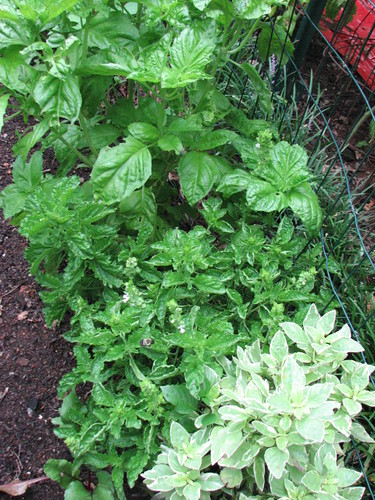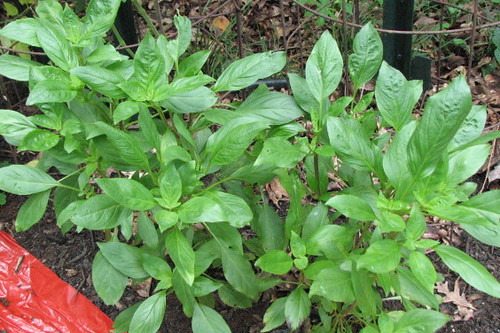How to Select and Use Basil Varieties (w/Stuffed Artichoke Recipe)
Nothing goes better with fresh garden tomatoes than fresh garden basil. It’s likely these two plants are responsible for the majority of intrepid forays into vegetable gardening.
Cooks and gardeners quickly find there is more to basil than the overpriced “sweet” grocery store blister packs or the spice aisle’s jars full of lifeless confetti. Basil is quick and easy to use — you often add it raw right at the end of cooking. Having a variety of basils in the garden can make serving what you grow much more exciting!

Photo Caption: From bottom right to upper left: 'Pesto Perpetuo' basil, 'Serrata' basil, and a Genovese type basil.
Though you can substitute one kind of basil for any other in a recipe, there are some that lend themselves well to specific uses. Basils with giant leaves can be used as salad greens, rolled around tasty fillings, or even used as little leaf plates for hors d’oeuvres. Colored or variegated basils make stunning edible garnishes. Some basils have extra vibrant flavors that stand up well in pestos and curries. Round, little leaf globe basils look beautiful in ornamental kitchen gardens and boast brilliant flavors to match. All basils have edible flowers that encourage visits from beneficial insects.
Over the years I’ve tried a lot of basils — I can’t help myself! Here are some of my observations along with potential sources. Note that you may want to use this alternate link for Pinetree Garden Seeds since their variety links open in small windows (for example, ‘Licorice’ basil and their mixed packet).
Basil Varieties to Try:
- ‘Genovese’ Basil – One of the most popular culinary basils with smooth leaves and a sweet, strong flavor.
- ‘Aroma 2’ F1 Hybrid Basil – Flavor similar to ‘Genovese’ but with better disease resistance and plant shape.
- ‘Lettuce Leaf’ Basil – Giant puckered leaves are fantastic in salads or used to wrap appetizers and other foods. One or two leaves can cover a tomato sandwich.
- ‘Napolletano Bolloso’ Basil – A massive basil with truly bright flavor, the leaves are as large as your hand.
- ‘Pesto Perpetuo’ Basil – This basil is being propagated through cuttings and sold as plants (I saw them at almost all the farmers markets and garden centers last spring). Kind of a guilty pleasure but the flavor is surprisingly good for a novelty and it really is a delight to look at on the plate.
- ‘Serrata’ Basil – This is the prettiest, tastiest, and most reliable ruffled green basil I’ve tried.
- ‘Green Ruffles’ Basil – Less reliable than ‘Serrata’ as a seed but the leaves are nice and big.
- ‘Violetto Aromatico’ Basil – I don’t find that the red/purple basils have as nice a flavor as the green ones but this one is decent. Note that the seedlings can come up “calico” as green and purple freckled plants instead of solid purple ones. Grow a lot of seedlings if you want to be sure you get solid red ones.
- ‘Red Rubin’ Basil – A popular red basil. Again, I think these are milder than green types.
- ‘Opal’ Basil – This purple basil is very ornamental and more compact than most. I like to plant several seedlings per transplant cell to increase the “bushiness” in the garden.
- ‘Osmin’ Basil – Nearly 100% true from seed dark basil with decent flavor.
- ‘Purple Ruffles’ Basil – Variable from seed but makes beautiful ruffled purple leaves. Mild flavor, best as a garnish or salad green.
- ‘Thai’ Basil – Traditional basil flavor mixed with clove undertones, great in Asian cooking.
- ‘Licorice’ Basil – Very strong flavor, bright and sweet. One of my favorite herbs this year.
- ‘Minette’ Basil – Very pretty round-shaped border basil with a strong flavor. Tiny leaves are nice garnishes, too.
- ‘Cinnamon’ Basil – A spicy cinnamon flavor perfect for curries and other vibrant dishes. The beautiful flowers are lovely for ornamental gardening and also attract beneficial insects.
- ‘Persian Anise’ Basil – Purple-tinged basil with hints of licorice.
- ‘Lemon’ Basil – The mild basil flavor is accompanied by a bright, lemony taste.
- ‘Mrs. Burn’s Lemon’ Basil (Ocimum americanum) – A very sweet and intense lemon basil with a bushier growth habit.
- ‘Lime’ Basil (Ocimum americanum) – Small, sturdy leaves with a distinct lime flavor.
- ‘Globe’ or ‘Greek’ Basil (Ocimum minimum) – Smaller leaves and a spicy taste, compact and pretty to use as veggie bed borders.
- ‘Basilico Finissimo Verde a Palla’ Basil (Ocimum minimum) – Tiny leaves with a very sweet flavor, great as a garnish, potted plant, or kitchen garden border.
- ‘Holy’ Basil (Ocimum sanctum) – An East Indian basil with an extra spicy flavor.
- “Mtule” Basil (Ocimum suave, medicinal) – Contains the same oil as cloves and has similar uses.
- Pinetree Seeds Basil Mix – Has almost any variety you could want in one seed packet.

Photo Caption: Not just an ornamental novelty, 'Pesto Perpetuo' basil's strong flavor stands up in your most vivacious recipes or you can use it as an equally sparkling garnish.
The cheapest way to grow a lot of basil varieties is to try a mixed seed packet like the one from Pinetree. You can also visit garden centers or farmers market plant sales but expect to pay up to $5.00 per transplant depending on where you get it.
You may notice that the bushiest transplants being sold at most centers have 2 – 5 seedlings in each pot. You can do this at home, too. Take 4 seeds and drop one into each corner of the cell when you start your transplants. Your basil seedlings will happily grow crowded together like this and you can space each multi-seedling “transplant” about 6″ – 12″ apart in the garden. The rounded shape is increased by pinching off the growing tips when they reach about 4″ high.

Photo Caption: Though I would not have thought regular basil needed any improvement, I am completely sold on 'Licorice' basil after it sprouted from Pinetree's mixed basil seed packet.
In spite of all the basils I’ve tried my favorite remained the simple exuberance of ‘Genovese’ until this season. Now my heart has been stolen by ‘Licorice’ basil and I use it as a substitute in sandwiches, pesto, stir-fry, and insalata Caprese. The sweet fennel undertones are lovely!
You can use any variety of basil in the following summer recipe, so here’s to daydreaming about this year’s garden!
Basil & Black Walnut Stuffed Artichokes
- 4 large artichokes
- 1 cup fresh basil leaves (any variety)
- 1 cup fresh parsley (can substitute more basil, chervil, mache, or arugula)
- 1 & 1/2 cups fresh bread crumbs
- 1/2 cup extra virgin olive oil
- 1/2 cup black walnuts (can toast walnuts lightly — if you don’t have black walnuts, substitute English walnuts, hazelnuts, pine nuts, Brazil nuts, or almonds)
- 2 cloves garlic
- 1 tablespoon capers OR 1 tablespoon dark (red) miso paste
- pinch of salt
- 1/4 cup freshly grated Parmigiano-Reggiano cheese
- Lemon wedges for serving
- Preheat oven to 400 F.
- Puree nuts, garlic, herbs, capers, and salt in a food processor until they form a rough paste. With machine running add olive oil in a steady stream. Add bread crumbs and cheese and pulse until well mixed.
- Wash & cut stems from artichokes. Cut off the top quarter of the artichoke with a sharp chef’s knife. With a pair of scissors clip the spines off the top of the exposed leaves and remove tough or damaged leaves.
- Coax the leaves apart to expose the center of the artichoke. Twist out the small, pale leaves at the center and use a spoon to scrape out the choke (rinse remaining bits of choke).
- Divide the filling into 4 even portions and spoon into the center cavity of the artichokes. If there are gaps between the leaves fill those as well. Some of the stuffing should remain on the surface so it becomes brown and crunchy in the oven.
- Put artichokes in a covered baking dish, casserole, or dutch oven and fill with 1 inch of hot water. Cover tightly and bake on center rack for 40 – 50 minutes. Check during cooking that water does not dry up — replace if needed. Artichokes are done when an outer leaf can be peeled off easily and the tender tip can be scraped off with your teeth.
- Allow to rest for up to 10 minutes and then serve with lemon wedges and dishes for discarded leaves. If you haven’t tried them before, this is how to eat an artichoke.
7 thoughts on “How to Select and Use Basil Varieties (w/Stuffed Artichoke Recipe)”
Comments are closed.

Liza - February 23, 2010 11:03 am
Oh my that recipe sounds delish! Great post, super informative and helpful, thanks so much!
Sustainahillbilly
Twitter: appalachianfeet
- February 23, 2010 2:47 pm
You’re welcome! I’m glad you liked it.
Barefootheart - February 23, 2010 3:39 pm
Wow, lots of great information here. I’ll enjoy looking over your past posts. Nice to find you!
Sustainahillbilly
Twitter: appalachianfeet
- February 23, 2010 4:13 pm
Thanks! I just love gall insects so your latest post with photos was a delight!
Pingback: How to Grow Vegetables (Archive Directory) | Appalachian Feet
Pingback: How to Plant Tomatoes (and Get the Best Root System) | Appalachian Feet
Timothy Odems - May 15, 2010 2:55 am
I came to this site by searching Bing. I must say that this looks enticing. Thanks for taking your time posting this recipe!